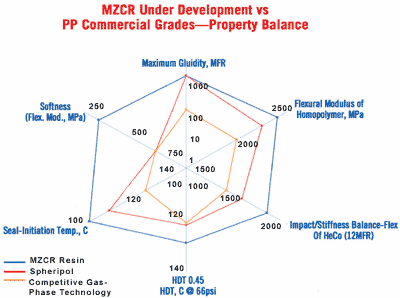New Process Makes More Homogeneous PP Homopolymers & Copolymers
New styles of resin reactors don’t come along very often.
New styles of resin reactors don’t come along very often. But some time in the next three months, Basell Polyolefins plans to start up in Bridisi, Italy, the first commercial-scale unit employing a brand-new, gas-phase loop technology. It is said to be unique in making highly homogenous multi-monomer resins or bimodal homopolymers in a single reactor.
Basell, whose U.S. offices are in Wilmington, Del., calls it the Multi-Zone Circulating Reactor (MZCR). It consists of a 120-ft-tall continuous loop of gas divided into two zones by a liquid monomer barrier that is held in place by tightly packed polymer particles. The different zones accomplish what other processes do with multiple gas-phase and slurry-loop reactors.
In the single MZCR reactor, the first zone starts out rich in propylene monomer (and a comonomer, if desired). The second zone is rich in hydrogen gas, and the high-velocity gas flow spreads the growing resin particles out more loosely. The two zones produce resins of different molecular-weight and/or monomer composition. Polymer granules grow as they travel round and round this loop, building up alternating layers of each polymer fraction like an onion. Each particle is thus an intimate combination of both polymer fractions.
The particles pass quickly up through the fluidizing gas in the “riser” side of the loop and come slowly down through the liquid monomer on the “down” side. Different monomers can be added in the two reactor legs. The reactor can use both conventional and single-site catalysts.
In the liquid/gas separation zone, the hydrogen gas is stripped off to cool and recirculate. Polymer granules are then densely packed into the “plug flow” section, through which they descend slowly. Monomers are introduced as liquids in this section. Conditions in the liquid-propylene plug-flow section can be varied with different combinations of monomers or different proportions of comonomer to propylene monomer in successive passes.
In-situ polymer blends
Basell claims that the resulting material combinations are more homogeneous and more easily processable than those made by conventional multi-reactor series. Resins are said to have fewer gels and to require less energy to extrude and pelletize. “Short chains and long chains can apparently be more intimately incorporated into the polymer, preserving the homogeneity of the resin,” says Dr. William D. Vernon of Chemical Market Resources Inc., a Houston-based polymer-industry research firm, in a review of the new reactor technology.
This unique loop reactor can make PP copolymers, terpolymers, and bimodal homopolymers, including some previously possible only with an elaborate series of reactors. The MZCR technology produces more homogeneous comonomer distribution than these multiple reactor series because each MZCR particle is an intimate blend of both material fractions, Basell says.
The MZCR reactor represents a further step beyond Basell’s multi-reactor Catalloy process, which was previously the only in-situ way to make PP copolymers with high ethylene-rubber content for automotive parts, roofing membranes, and films that combine high stiffness and high impact . MZCR can also produce in-reactor blends of homopolymer and random copolymer or of two random copolymers.
According to Basell’s patents, MZCR reactors can make HDPE homo- and copolymers, LLDPE with 0.88 to 0.94 g/cc density, EPDM, impact PP, and PP copolymers with ethylene or other alpha-olefins.
The MZCR loop can also be paired with a Basell gas-phase reactor downstream to make heterophasic copolymers with higher impact/stiffness balance or greater softness than are made with other processes. As an example of what MZCR can do, a researcher cites a 12-MFR resin with notched Izod impact of 1.4 ft-lb/in. Tensile modulus is around 261,000 psi with MZCR vs. about 232,000 psi for a similar resin made with the latest-generation Spheripol reactor.
Wide licensing possible
Once Basell’s commercial trials are completed, MZCR has the potential for wide adoption by the company’s licensees because it can be retrofitted into existing Spheripol plants. The plants could continue to make Spheripol products as well as new materials. Spheripol is the most widely used process to make PP in the world, accounting for over 35% of global production, according to Chemical Market Resources. MZCR offers cost savings to resin producers because the catalyst yields twice as much output and grade changes are faster.
Related Content
Research Suggests Path From Waste Plastics to High Value Composites
Flash joule heating could enable upcycling of waste plastic to carbon nanomaterials.
Read MoreRead Next
Advanced Recycling: Beyond Pyrolysis
Consumer-product brand owners increasingly see advanced chemical recycling as a necessary complement to mechanical recycling if they are to meet ambitious goals for a circular economy in the next decade. Dozens of technology providers are developing new technologies to overcome the limitations of existing pyrolysis methods and to commercialize various alternative approaches to chemical recycling of plastics.
Read MoreTroubleshooting Screw and Barrel Wear in Extrusion
Extruder screws and barrels will wear over time. If you are seeing a reduction in specific rate and higher discharge temperatures, wear is the likely culprit.
Read MoreUnderstanding Melting in Single-Screw Extruders
You can better visualize the melting process by “flipping” the observation point so that the barrel appears to be turning clockwise around a stationary screw.
Read More










.png;maxWidth=300;quality=90)

 (2).jpg;maxWidth=300;quality=90)










